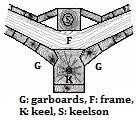Garboard on:
[Wikipedia]
[Google]
[Amazon]

 On a vessel's
On a vessel's

 On a vessel's
On a vessel's hull
Hull may refer to:
Structures
* Chassis, of an armored fighting vehicle
* Fuselage, of an aircraft
* Hull (botany), the outer covering of seeds
* Hull (watercraft), the body or frame of a ship
* Submarine hull
Mathematics
* Affine hull, in affi ...
, a strake is a longitudinal course of planking or plating which runs from the boat's stempost (at the bows) to the sternpost or transom
Transom may refer to:
* Transom (architecture), a bar of wood or stone across the top of a door or window, or the window above such a bar
* Transom (nautical), that part of the stern of a vessel where the two sides of its hull meet
* Operation Tran ...
(at the rear). The garboard strakes are the two immediately adjacent to the keel on each side.
The word derives from traditional wooden boat building methods, used in both carvel and clinker
Clinker may refer to:
*Clinker (boat building), construction method for wooden boats
*Clinker (waste), waste from industrial processes
*Clinker (cement), a kilned then quenched cement product
* ''Clinkers'' (album), a 1978 album by saxophonist St ...
construction. In a metal ship, a strake is a course of plating.
Construction
In small boats strakes may be single continuous pieces of wood. In larger wooden vessels strakes typically comprise several planks which are either scarfed, or butt-jointed and reinforced with a butt block. Where the transverse sections of the vessel's shape are fuller, the strakes are wider; they taper toward the ends. In a riveted steel ship, the strakes were usually lapped and joggled (one strake given projections to match indentions in the one adjoining), but where a smoother finish was sought they might be riveted on a butt strap, though this was weaker. In modern welded construction, the plates are normally butt-welded with full penetration welds all round to adjoining plates within the strake and to adjoining strakes.Terminology
In boat and ship construction, strakes immediately adjacent to either side of the keel are known as the ''garboard strakes'' or ''A strakes''. The next two are the first broad or ''B'' strake and second broad or ''C'' strake. Working upward come the bottom strakes, lowers, bilge strakes, topside strakes, and uppers also named sequentially as the ''D'' strake, ''E'' strake, etc. The uppermost along the topsides is called the sheer strake. Strakes are joined to thestem
Stem or STEM may refer to:
Plant structures
* Plant stem, a plant's aboveground axis, made of vascular tissue, off which leaves and flowers hang
* Stipe (botany), a stalk to support some other structure
* Stipe (mycology), the stem of a mushro ...
by their hood ends.
A rubbing strake was traditionally built in just below a carvel sheer strake. It was much less broad but thicker than other strakes so that it projected and took any rubbing against piers or other boats when the boat was in use. In clinker
Clinker may refer to:
*Clinker (boat building), construction method for wooden boats
*Clinker (waste), waste from industrial processes
*Clinker (cement), a kilned then quenched cement product
* ''Clinkers'' (album), a 1978 album by saxophonist St ...
boats, the rubbing strake was applied to the outside of the sheer strake. Many current pleasure craft reflect this history in that they have a mechanically attached (and therefore replaceable) rub rail at the location formerly occupied by a rubbing strake, often doubling to cover the joint between a GRP hull and its innerliner. Inflatable dinghies and RIB
In vertebrate anatomy, ribs ( la, costae) are the long curved bones which form the rib cage, part of the axial skeleton. In most tetrapods, ribs surround the chest, enabling the lungs to expand and thus facilitate breathing by expanding the ches ...
s usually have a rubbing strake (typically a glued-on rubber extrusion) at the edge.
A "stealer" is a short strake employed to reduce the width of plank required where the girth of the hull increases or to accommodate a tuck in the shape. It is commonly employed in carvel and iron/steel shipbuilding, but very few clinker craft use them.
Sources
{{sailing ship elements Shipbuilding fi:Laidoitus